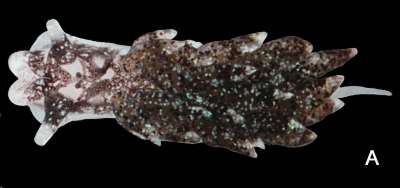
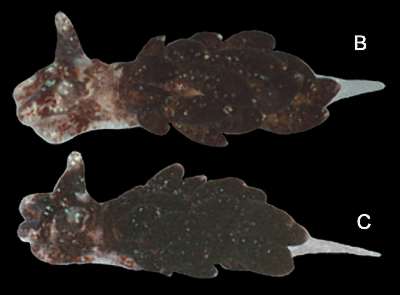
Costasiella nonatoi
Marcus & Marcus, 1960
Order: SACOGLOSSA
Superfamily: LIMAPONTIOIDEA
Family: Costasiellidae
DISTRIBUTION
Caribbean, Brazil
PHOTO
A. 3mm. On Avrainvillea nigricans in 0.5m. Treasure Cay, July 3, 1992. B. 1.5mm. On an algae-covered rock in the surf zone, ocean side of Whale Cay, July 1, 1996. Rodger Bunnell, collector. C. 2.5mm. On Cladophora in 0.5m, Guana Cay, February 19, 2004. All locations in Abaco, Bahamas. Photos: Colin Redfern.
Marcus's original description from Brazil describe a predominantly black animal with white along the anterior edge of the foot, and a white lines up the outer edge of each rhinophore to the white tip. The cerata are also white-tipped. There is a large white patch around each eye, which touch in the midline. Redfern's animals from the Bahamas show a white edge to the foot and a considerable degree of white spotting over the body. Redfern suggests that it doesn't grow much larger than 3mm long and although it is normally associated with it algal food Avrainvillea nigricans, it is sometimes found on Cladophora.
References:
• Clark, K.B. (1984) New records and synonymies of Bermuda opisthobranchs (Gastropoda). The Nautilus, 98(2): 85-97.
• Marcus, Ev. & Marcus, Er. (1960) Opisthobranchs from American Atlantic warm waters. Bull. Mar. Sci. 10(2): 129-203.
• Redfern. C., 2001. Bahamian Seashells: a Thousand Species from Abaco, Bahamas.
Rudman, W.B., 2004 (March 1) Costasiella nonatoi Marcus & Marcus, 1960. [In] Sea Slug Forum. Australian Museum, Sydney. Available from http://www.seaslugforum.net/find/costnona
Related messages
Costasiella nonatoi from the Bahamas
March 4, 2004
From: Colin Redfern


Dear Bill,
To add to Marina's record [#12355] of Costasiella nonatoi from the Bahamas, here are photos of three specimens from Abaco. The dark brown color in these photos may be a bit misleading, as the animals appear predominantly black in life, and also appear blacker when photographed against a lighter background.
Clark (1984) reported that "individuals burrow into the felty thallus of Avrainvillea to feed and deposit egg masses".
A. 3mm. On Avrainvillea nigricans in 0.5m. Treasure Cay, July 3, 1992. B. 1.5mm. On an algae-covered rock in the surf zone, ocean side of Whale Cay, July 1, 1996. Rodger Bunnell, collector. C. 2.5mm. On Cladophora in 0.5m, Guana Cay, February 19, 2004. All locations in Abaco, Bahamas. Photos: Colin Redfern.
• Clark, K.B. 1984. New records and synonymies of Bermuda opisthobranchs (Gastropoda). The Nautilus, 98(2): 85-97.
Best wishes,
Colin
bahamianseashells@att.net
Redfern, C., 2004 (Mar 4) Costasiella nonatoi from the Bahamas. [Message in] Sea Slug Forum. Australian Museum, Sydney. Available from http://www.seaslugforum.net/find/12365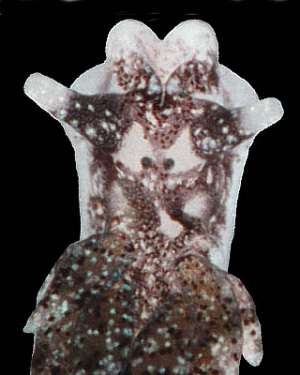
Thanks Colin,
I've included a close-up of the head of one of your animals to show some of the colour detail which is usually missed (or obscured by black pigment) in such small 'black' animals.
Best wishes
Bill Rudman
Costasiella nonatoi from Bahamas
March 3, 2004
From: Marina Poddubetskaia
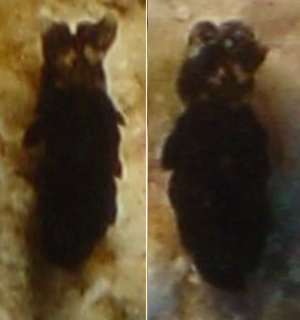
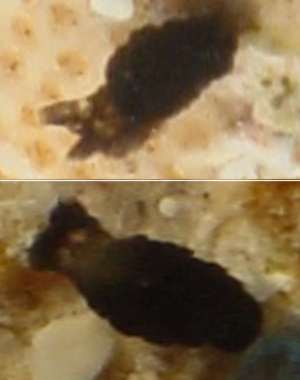
Dear Bill,
During my diving cruise in the Northern Bahamas I found 3 tiny black guys in a sandy (beach) area while snorkelling. All of them were 2mm in length and they were crawling on the sand. At first sight, under the water, I mistook them for Ercolania viridis. But a look at photos revealed 2 close eyes, so I have no doubts they are a Costasiella species.
I've asked Kathe Jensen about a possible identification and she answered they could be Costasiella nonatoi. I'd like to have your opinion too, please. I'm sorry for so poor photos, but my camera couldn't do better with so small specimens.
Bimini Islands, Bahamas, Western Atlantic. Site: Bimini Road. Depth: 1m. Size: 2mm. February 12, 2004. Photos: Marina Poddubetskaia - Nembro website
Cheers,
Marina.
nembro@nembro.info
Poddubetskaia, M., 2004 (Mar 3) Costasiella nonatoi from Bahamas. [Message in] Sea Slug Forum. Australian Museum, Sydney. Available from http://www.seaslugforum.net/find/12355Dear Marina,
I am sure Kathe's suggestion is the most likely. Colin Redfern says that it doesn't grow much larger than 3mm long. Although it is normally associated with it algal food [Avrainvillea nigricans, and sometimes Cladophora] I guess at times they wash off their food, or the plant dies, or is eaten. Redfern's animals from the Bahamas show quite a bit of white spotting and mottling, but the Marcus's original description from Brazil describe a predominantly black animal with white along the anterior edge of the foot, and a large white patch around each eye, which matches your animals well
• Redfern. C., 2001. Bahamian Seashells: a Thousand Species from Abaco, Bahamas.
Best wishes
Bill Rudman
